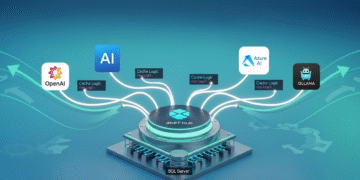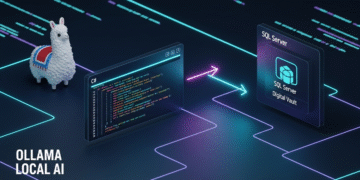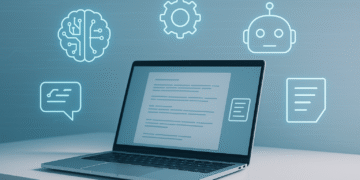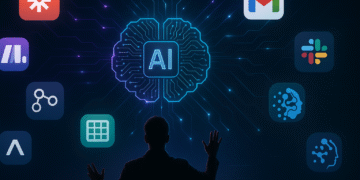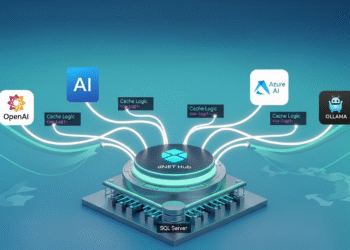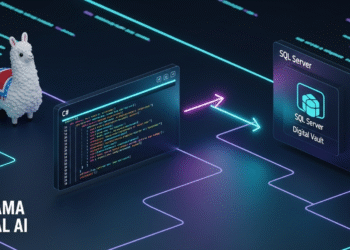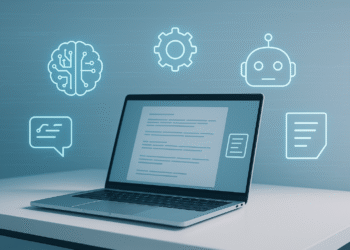The tech world is changing fast, thanks to Bubble No-Code. It’s making it easy for over 1 million users to create complex apps without coding.
This change worries IT professionals who think their jobs might disappear. But, no-code tools like Bubble are opening doors for both tech-savvy and non-tech people.
As the no-code trend keeps growing, it’s key to grasp its impact. And how you can profit from it.
Key Takeaways
- No-code development platforms are revolutionizing the tech industry.
- Bubble No-Code is a leading platform with over 1 million users.
- IT experts are adapting to new opportunities created by no-code tools.
- Non-technical individuals can now build complex applications without coding.
- The no-code movement is expected to continue growing in the coming years.
The No-Code Revolution and the IT Expert Paradox
No-code solutions are becoming more popular, but IT experts are finding it hard to keep up. This change is making it easier for people without coding skills to create complex apps.
What is Bubble No-Code?
Bubble is a no-code tool that lets users make web apps without coding. It uses a visual interface for designing, developing, and deploying apps. This makes it easy for non-techies to build applications.

The Surprising Struggle of Technical Professionals
Many IT pros are having trouble switching to no-code platforms. They struggle because they need to unlearn old coding ways and learn new visual development tools.
The Opportunity for Non-Technical Builders
No-code tools like Bubble give non-tech people a chance to build apps. This opens up new opportunities in tech for entrepreneurs and business users. They can create solutions without needing to code.
| Aspect | Traditional Coding | No-Code Solutions |
|---|---|---|
| Development Speed | Slow, due to manual coding | Fast, using visual interfaces |
| Required Expertise | Extensive coding knowledge | Basic understanding of logic and processes |
Why Traditional Developers Hit a Wall with No-Code
Traditional developers often struggle with no-code platforms. This is because they are used to coding. Switching to visual tools is a big change.
The Coding Mindset vs. Visual Development
Developers used to coding find it hard to switch to no-code platforms like Bubble. No-code uses drag-and-drop and config windows instead of code. This change is tough for those who have spent years coding.
Jason Fried, co-founder of Basecamp, said, “The best code is no code at all.” This shows the idea behind no-code: making development simpler by avoiding manual coding.
Unlearning Technical Complexity
No-code platforms hide the technical details that developers are used to. This makes it easier to develop but hard to adjust. Developers must unlearn old habits and trust the platform to handle the complexity.
| Aspect | Traditional Coding | No-Code Development |
|---|---|---|
| Development Method | Writing code | Visual development |
| Technical Complexity | High | Abstracted away |
| Learning Curve | Steep | More accessible |
The Freedom-Structure Dilemma
No-code platforms balance freedom and structure. They let you create apps without coding but also guide the process. This balance can feel both freeing and limiting, depending on the developer.

In conclusion, traditional developers face many challenges with no-code development. They must change their mindset, unlearn old ways, and find the right balance between freedom and structure. Understanding these challenges is key for both developers and no-code platform providers.
Bubble No-Code: Why IT Experts Struggle (And How You Can Profit)
IT experts find it hard to use no-code tools like Bubble. This creates a big opportunity for non-coders. As more people use no-code tools, it’s clear that coding skills aren’t always needed.
The Market Gap Created by This Paradox
IT experts’ trouble with no-code tools has left a big gap in the market. This gap is perfect for non-technical people who are eager to learn. By understanding IT experts’ challenges, non-coders can fill this gap well.
Non-technical builders can make money by helping businesses use no-code tools. They can build apps, create workflows, and offer training. All this can be done without needing to code.
Skills That Give Non-Coders an Edge
Non-coders have a different view that can be very useful. They bring skills like business knowledge, design thinking, and project management. They also learn new tools fast, making them more flexible than tech experts.
By using these skills, non-coders can not only compete but also work well with tech experts. Together, they can make better no-code solutions.
Your Competitive Advantage in the No-Code Economy
To stand out in the no-code world, know what makes you special. For non-coders, it might be their non-technical view, quick learning, or marketing skills.
By profiting from no-code and finding your niche in Bubble, you can be different. You could become an expert in a certain field or develop a unique way of no-code development.
Real Success Stories: Non-Coders Who Built Profitable Bubble Apps
Bubble has made app development easy for non-coders. Its simple interface and strong features let people from all walks of life create and launch apps that make money.
From Marketing Manager to SaaS Founder
A marketing manager turned SaaS founder with Bubble, without coding skills. They made a SaaS product that now brings in a lot of money. Their story shows how bubble no-code can change careers.
The Consultant Who Built a $50K/Month Business
A business consultant used Bubble to make an app that met client needs. It now makes $50,000 a month. This shows no-code development can lead to big profits.
How a Teacher Created an EdTech Platform
A teacher used Bubble to make an EdTech platform. It improved student learning and engagement. This shows Bubble no-code can make a big impact in education.
Lessons from Their Success Journeys
These stories share key traits. They knew their market well, were open to learning, and used Bubble’s features well. By learning from them, aspiring no-code developers can make their own successful apps.
Getting Started with Bubble: Your First Application
Building your first app with Bubble is easy, even if you don’t know how to code. This no-code tool lets you make complex web apps without writing code.
Setting Up Your Bubble Account
Start by setting up your Bubble account. Go to the Bubble website and sign up. You can use the free plan to try it out without spending money. After signing up, you’ll get an email to confirm your account.
Understanding the Bubble Interface
After logging in, you’ll see the Bubble dashboard. It might look a bit confusing at first. But, it’s made to be easy to use. You’ll find the page editor for designing your app’s UI and the workflow editor for the app’s logic.
Building Your First Page
To begin, create a new page. This is where you design your app’s UI. Bubble has a drag-and-drop editor to add things like text, buttons, and images.
Elements and Layout
Bubble has many elements to build your page. You can use simple things like text and rectangles or more complex things like forms. You can arrange these elements with a grid system or by setting their positions.
Responsive Design Basics
Bubble makes it easy to create apps that look good on any device. Your app will change its layout to fit different screens. This ensures a great experience on desktops and mobiles. You can customize how your app looks on different devices.
| Device Type | Screen Size | Bubble’s Responsive Behavior |
|---|---|---|
| Desktop | Large screens | Optimized for complex layouts |
| Tablet | Medium screens | Adjusts layout for readability |
| Mobile | Small screens | Simplifies layout for ease of use |
Creating Simple Workflows
After designing your page, add some functionality. Workflows in Bubble define how your app reacts to user actions. For example, you can make a workflow that sends a confirmation email when someone signs up. Bubble’s workflow editor is easy to use, even for complex logic.
Step-by-Step Tutorial: Building a Profitable MVP
To profit from no-code platforms, start with a solid Minimum Viable Product (MVP). I’ll show you how to do this with Bubble. An MVP lets you test your idea with little cost, get user feedback, and improve your product.
Defining Your App’s Core Functionality
Before using Bubble, know what your app does best. Identify the main problem it solves, its key features, and the user’s path. Start by explaining your app’s main purpose and how it helps users.
- Identify the main problem your app solves
- List the key features required for the MVP
- Sketch the user journey
Setting Up Your Database Structure
A good database is key for any app. In Bubble, you create data types, fields, and relationships.
Creating Data Types
Data types in Bubble are for different kinds of app info. For example, a marketplace might have “Users,” “Products,” and “Orders.”
- Create a data type for each major entity in your app
- Define the fields that each data type will contain
Defining Fields and Relationships
Fields in a data type hold specific info. For instance, “User” might have “Name,” “Email,” and “Password.” Relationships connect related info.
- Define fields that capture necessary information
- Establish relationships between data types
Creating Complex Workflows and Logic
Workflows in Bubble make your app interactive. They let you automate actions based on user actions or other triggers.
Conditional Statements
Conditional statements help you create logic-based workflows. For example, show certain content only if a user is logged in.
- Use “If-Then” conditions to control workflow actions
- Create complex logic by chaining multiple conditions
Scheduled Events
Scheduled events run workflows at set times or intervals. This is great for tasks like sending reminders or updating data.
- Schedule events to occur at specific times
- Use recurring events for regular tasks
Implementing User Authentication
User authentication is key for managing access and personalizing experiences. Bubble has built-in features for easy integration.
- Set up user authentication to secure access
- Use authentication to personalize user experiences
Testing and Iterating Your MVP
After building your MVP, test and improve it. Get feedback from early users, see how they use your app, and make changes.
- Test your MVP with a small group of users
- Iterate based on feedback and performance data
By following these steps, you can create a profitable MVP with Bubble no-code. Start small, improve fast, and focus on user value.
How Bubble Compares to Other No-Code Platforms
Bubble is one of many no-code platforms out there. Knowing its strengths and weaknesses is crucial. As the no-code world grows, comparing Bubble to others helps you choose wisely.
Bubble vs. Webflow: When to Use Each
Choosing between Bubble and Webflow depends on your project needs. Webflow is great for making websites with complex features. Bubble is better for web apps with dynamic functions.
If your project needs detailed user interactions and data handling, Bubble is the better pick.
Bubble vs. Adalo for Mobile Apps
Adalo is a top choice for mobile app development. But, Bubble can also make mobile apps. For apps needing complex workflows and data features, Bubble’s flexibility might win over Adalo.
Bubble vs. Softr and Glide
Softr and Glide focus on different areas of app development. Softr is best for internal tools and dashboards. Glide is great for making mobile apps from Google Sheets. Bubble, however, offers a wide range of app possibilities, from simple sites to complex web apps.
The Unique Advantages of Bubble
Bubble stands out for its versatility and feature depth. It lets you build complex, data-driven apps without coding. This makes it perfect for those wanting to create advanced web apps fast.
| Platform | Strengths | Weaknesses |
|---|---|---|
| Bubble | Versatile, complex applications, data-driven | Steeper learning curve |
| Webflow | Responsive design, complex interactions | Limited application functionality |
| Adalo | User-friendly, mobile app development | Limited web application capabilities |
| Softr | Internal tools, dashboards | Limited public-facing application capabilities |
| Glide | Mobile apps from Google Sheets | Limited customization |
Monetization Strategies for Your Bubble Applications
Building a no-code app is just the start. To make money, you need to know how to make it profitable. Bubble developers have many ways to make their apps pay off.
Building and Selling SaaS Products
One top way to make money is by selling SaaS products. SaaS gives you a steady income, which is great for developers.
Pricing Models That Work
There are many pricing options for your SaaS:
- Freemium Model: Give a basic version free and charge for more.
- Subscription-Based: Get users to pay a regular fee.
- Usage-Based: Charge based on how much users use your app.
Customer Acquisition Strategies
Getting customers is key for your SaaS. Good ways to do this include:
- Content Marketing: Make content that draws in potential customers.
- Social Media Marketing: Use social media to find your audience.
- Influencer Marketing: Work with influencers to promote your app.
As Forbes says, “The secret to a successful SaaS is keeping customers, not just getting them.”
“Keeping customers is what makes a SaaS successful. It’s not just about keeping them; it’s about making them your brand’s fans.”
Forbes
Creating Client Solutions as a Bubble Developer
Another good way is to make custom solutions for clients. As a Bubble developer, you can help businesses go digital without needing to code.
Productized Services Using Bubble
Turning your skills into products is another way to make money. This could be templates, plugins, or training on Bubble.
Marketplace and Template Business Models
Selling templates can give you a steady income. Bubble’s system lets you make and sell reusable parts and templates to other developers.
By trying different ways to make money, you can earn more in the no-code world. Whether it’s SaaS, custom solutions, or templates, Bubble helps you turn your ideas into money-makers.
Advanced Bubble Techniques and Best Practices
To create advanced no-code solutions with Bubble, it’s key to know the latest techniques and best practices. As you move from simple to complex apps, making your app fast is crucial.
Optimizing Performance
To make your Bubble app run smoothly, use several strategies. First, manage your data well by organizing your database. This way, you avoid getting too much data that you don’t need.
Also, use indexed fields to make searches and queries faster. This is a big help in keeping your app quick.
| Optimization Technique | Description | Benefit |
|---|---|---|
| Efficient Data Management | Structuring the database to minimize unnecessary data retrieval | Faster data processing |
| Indexed Fields | Using indexed fields for faster searches and queries | Improved search speed |
| Workflow Optimization | Simplifying and streamlining workflows to reduce execution time | Enhanced user experience |
API Integrations and Plugins
Bubble lets you add new features by linking to outside services through APIs. Plugins can also make complex tasks easier and improve how users interact with your app.
Custom Code When Necessary
Even though Bubble is a no-code platform, sometimes you need custom code. This is true when you need to do something special or connect with specific services. Adding custom JavaScript code can help you get around limits and make your app better.
Scaling Your Bubble Application
As more people use your app, you’ll need to make it bigger. This means keeping an eye on how well it works, making database queries better, and maybe using outside services for hard tasks.
Security Best Practices
Keeping your Bubble app safe is very important. Make sure you have good authentication and authorization, check user input, and update your app often to fix security issues.
By learning these advanced tips and best practices, you can make strong, growing, and safe no-code apps with Bubble. This way, you can use all that no-code tools and platforms have to offer.
Conclusion: Your No-Code Journey Starts Now
The no-code revolution is changing how we make and use digital products. We’ve seen how IT experts face challenges when using platforms like Bubble No-Code. Their old coding ways can make it hard to use no-code tools fully.
But there’s a big chance here. It’s not just about knowing Bubble’s tech side. It’s about learning a new way to think and develop quickly. People without coding skills can use Bubble No-Code to make new things and do well in the no-code world.
If you’re thinking about joining this new world, now is the time. Whether you’re an IT pro or someone new, Bubble No-Code makes it easy to start. The doors are open, and the chances for growth and new ideas are huge.
FAQ
What is Bubble No-Code, and how does it work?
Bubble No-Code is a platform that lets you build web apps without coding. It uses a visual interface for designing, developing, and deploying apps. This makes it easy for people who aren’t tech-savvy to use.
Why do IT experts struggle with Bubble No-Code?
IT experts find Bubble No-Code hard because they’re used to coding. They have to get used to a visual way of developing apps. This change can be tough.
What skills are required to succeed with Bubble No-Code?
To do well with Bubble No-Code, you need to know how to use the platform. You also need to design good user experiences and understand data structures. People with a business or design background can use these skills to make money.
How can I monetize my Bubble applications?
You can make money from your Bubble apps in several ways. You can sell SaaS products, offer client solutions, or provide services. You can also use marketplace and template models.
How does Bubble compare to other no-code platforms like Webflow and Adalo?
Bubble is great for making complex web apps. Webflow is better for design and front-end work, and Adalo is for mobile apps. But Bubble is versatile and easy to use, making it popular.
What are some best practices for securing my Bubble application?
To keep your Bubble app safe, use good user authentication and validate user input. Also, make sure to encrypt data. Always check and update your app’s security to stay safe.
Can I integrate external APIs and plugins with Bubble?
Yes, you can add external APIs and plugins to Bubble. This lets you connect with services, improve user experience, and automate tasks.
How do I optimize the performance of my Bubble application?
To make your Bubble app run better, focus on good data structure and fewer workflows. Also, work on page load times. Keep an eye on your app’s performance and tweak it for a better user experience.



